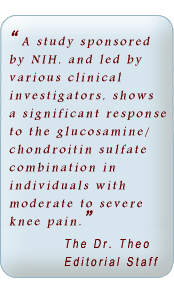GAIT Trial Results
Current News
Past News
Home Page
News
Supplements
Resources
Products
Books
Q & A
About Dr. Theo
 
|
The one thing the study did was help reiterate the fact that it's almost impossible to do osteoarthritis study that can validly assess both at the effect of pain relief and function improvement while at the same time assessing structural changes. The reason for this lies in the fact that you really need different patient populations to accurately assess each of these outcomes. Having a "mixed" patient population usually results in a high probability of false negative results for either or both outcomes. We'll see this same problem in the second part of GAIT, due out shortly.
So what is the proper way to assess pain/function versus structure changes? It's very clear from multiple studies that if you want to look at pain relief and function improvement from a proposed treatment for osteoarthritis, you need to choose patients who actually have significant levels of pain and functional impairment. The patients must have room to improve to detect a change from the beginning to the end of the study. On the other hand, if you want to look at structural changes of the cartilage, as measured by serial x-ray evaluations, or perhaps MRI scans in the near future, it's important to choose patients who have very little pain and functional difficulties. The reason is very clear. Structural changes in cartilage are often not associated with any changes in pain. Not a very surprising revelation since cartilage doesn't have any nerve endings. If you're going to keep patients in this study for a long period of time, you have to pick patients who are experiencing only mild or moderate symptoms. If you don't, one of two things will happen: either too many patients will drop out of the study (yielding inconclusive or false negative results), or the patients will require so much rescue medicine that this medicine in itself will be a confounder to the results. You can't have people taking a lot of pain medicine during a study because you won't know if the changes they experience before and after treatment are related to the study intervention, or the medication they need to control their symptoms.
Since people with osteoarthritis have the disease for decades, and loss of cartilage is a very slow phenomenon, it takes a long time to be able to detect a difference (as measured by before and after quantitative x-ray analysis). Remember, the changes in the width of the joint space are only a fraction of a millimeter per year. Many people have questions whether one year, or even to your studies are actually adequate to detect changes in joint space width. The two x-ray studies on glucosamine were of three years in duration and both yielded positive effects (i.e. the glucosamine sulfate actually slowed the loss of cartilage compared to placebo in a statistically significant manner). Curiously, in the only study that compared the results of joint space narrowing at both year 2 and year 3 indicated that the benefit of glucosamine accelerated the preservation of cartilage in his final year of the analysis. In other words, the biggest difference between the glucosamine group and the placebo group occurred between the years two and three.
It should also be noted that the longest duration study ever performed with any of these supplements (or drugs for that matter) is an eight-year follow-up of patients who took glucosamine sulfate or a placebo for the initial three years. In this study, those who used the glucosamine were 73% less likely to end up with the joint replacement compared to those who took the placebo. This is the kind of real world, outcome measure that really matters most if you're a patient or a physician who treats patients with osteoarthritis. Don't you really want to know what will happen in the long-term?
Another thing not mentioned in this article is the use of medication prior to entering the study as well as rescue medicine during the study. One of the confounding factors was the fact that those patients who were assigned to the glucosamine group were more likely to be using pain medications on a daily basis: 29% (versus 19% for those taking a placebo).
Were the glucosamine users able to decrease their daily medicine use? In table 4 on page 275 of the study, glucosamine users had about 29% less medication use from the start of the study. This was a trend and was not considered to be statistically significant. Even if these patients didn't experience pain relief or benefits in the relatively short-term x-ray evaluation of two years, decreasing medication use itself would be a positive outcome for this study. We don't want people to take medicine for osteoarthritis. Acetaminophen, even in low dose can elevate blood pressure and anti-inflammatory drugs (over-the-counter or prescription) are riddled with a whole host of problems including: bleeding ulcers, kidney and liver damage, elevated blood pressure, and perhaps increased risk of heart attack and stroke. It's no wonder that the package inserts for these medications detail a message from the FDA: "use the smallest dose for the shortest period of time possible”. If glucosamine can help lower the use of medication, it's important to make sure to give it to patients with osteoarthritis.
My final message relates to the fact that most people use the combination of glucosamine and chondroitin. This is been my theory all along dating back to the early 1990s. In every single experiment comparing the effect of glucosamine or chondroitin alone to the combination of glucosamine plus chondroitin, the combination has proved superior. This applies to basic science cartilage experiments, animal experiments and even the results from the first part of the NCAAM funded Glucosamine/Chondroitin Arthritis Intervention Trial (GAIT), of which I am an oversight committee member.
Unfortunately, too many unsophisticated osteoarthritis sufferers will simply to read the headlines in the paper related to studies on glucosamine or chondroitin alone, and make the unfortunate decision to withhold these beneficial supplements from their osteoarthritis treatment armamentarium. Many will end up using less safe interventions, such as drugs and surgery. This is a problem.
|

Learn about and purchase the book90% of people who follow The Arthritis Cure treatment program don't need anti-inflammatories (like Aleve, Celebrex or Advil).
Dr. Theo warned people that these drugs, used first... read more
|
|


